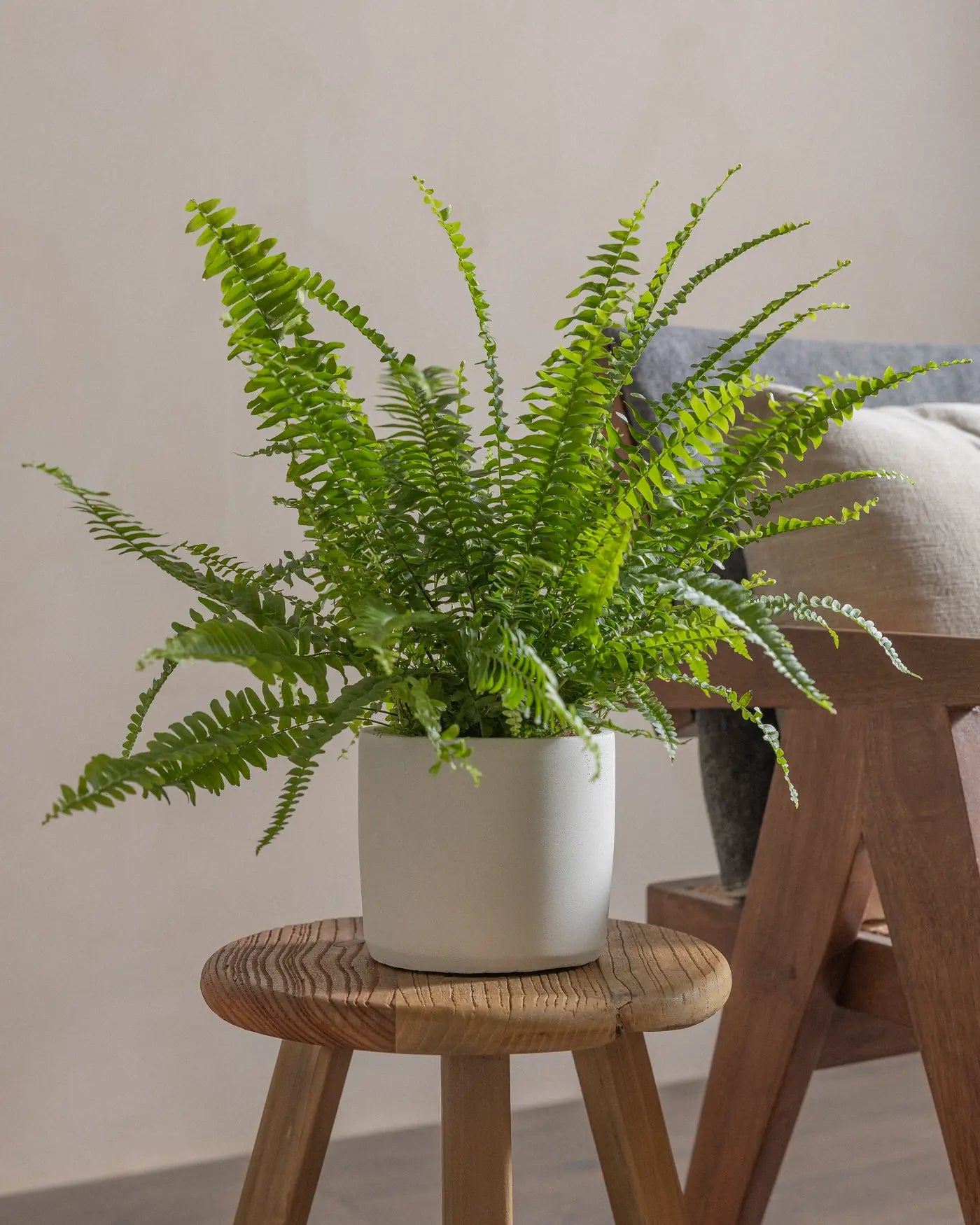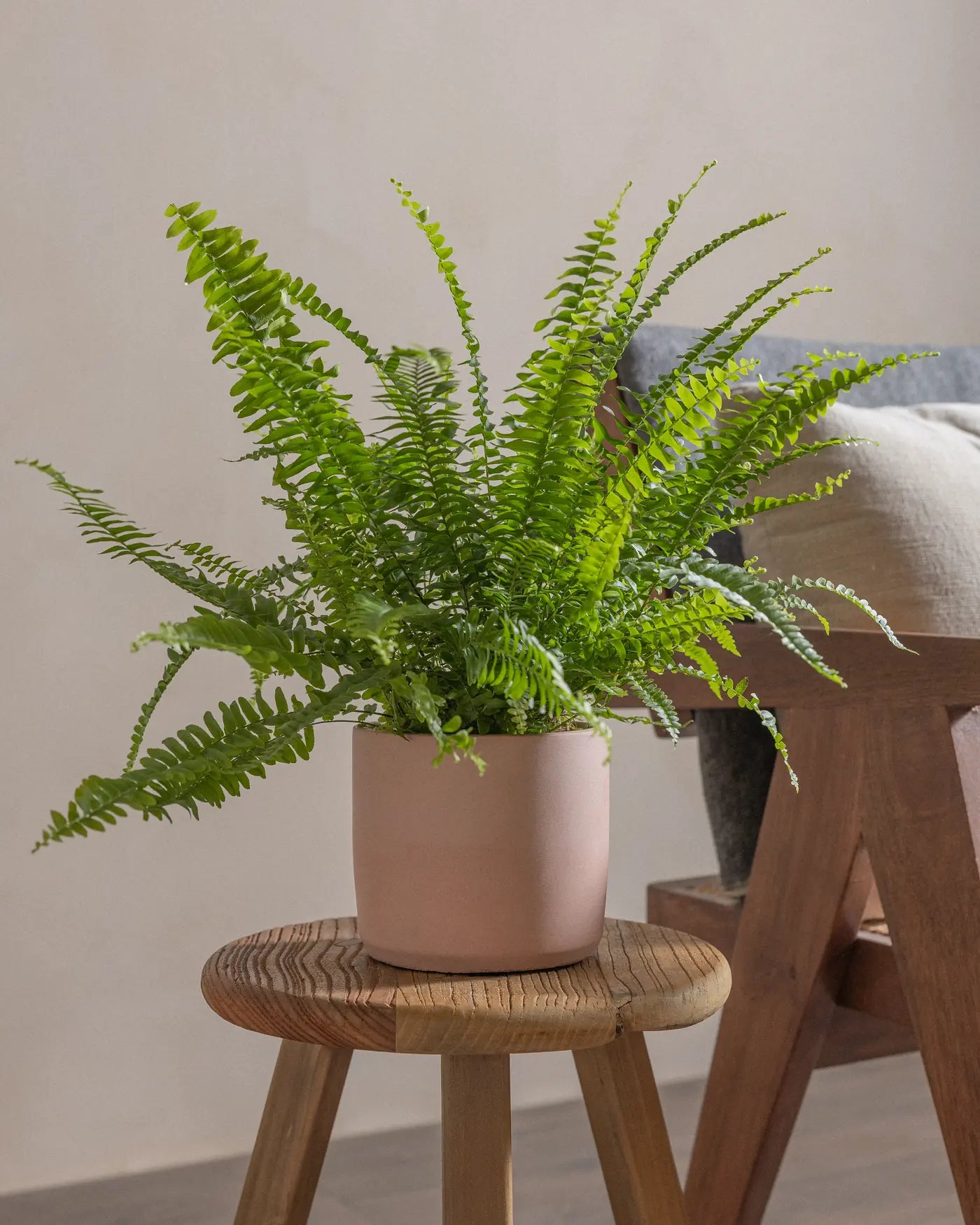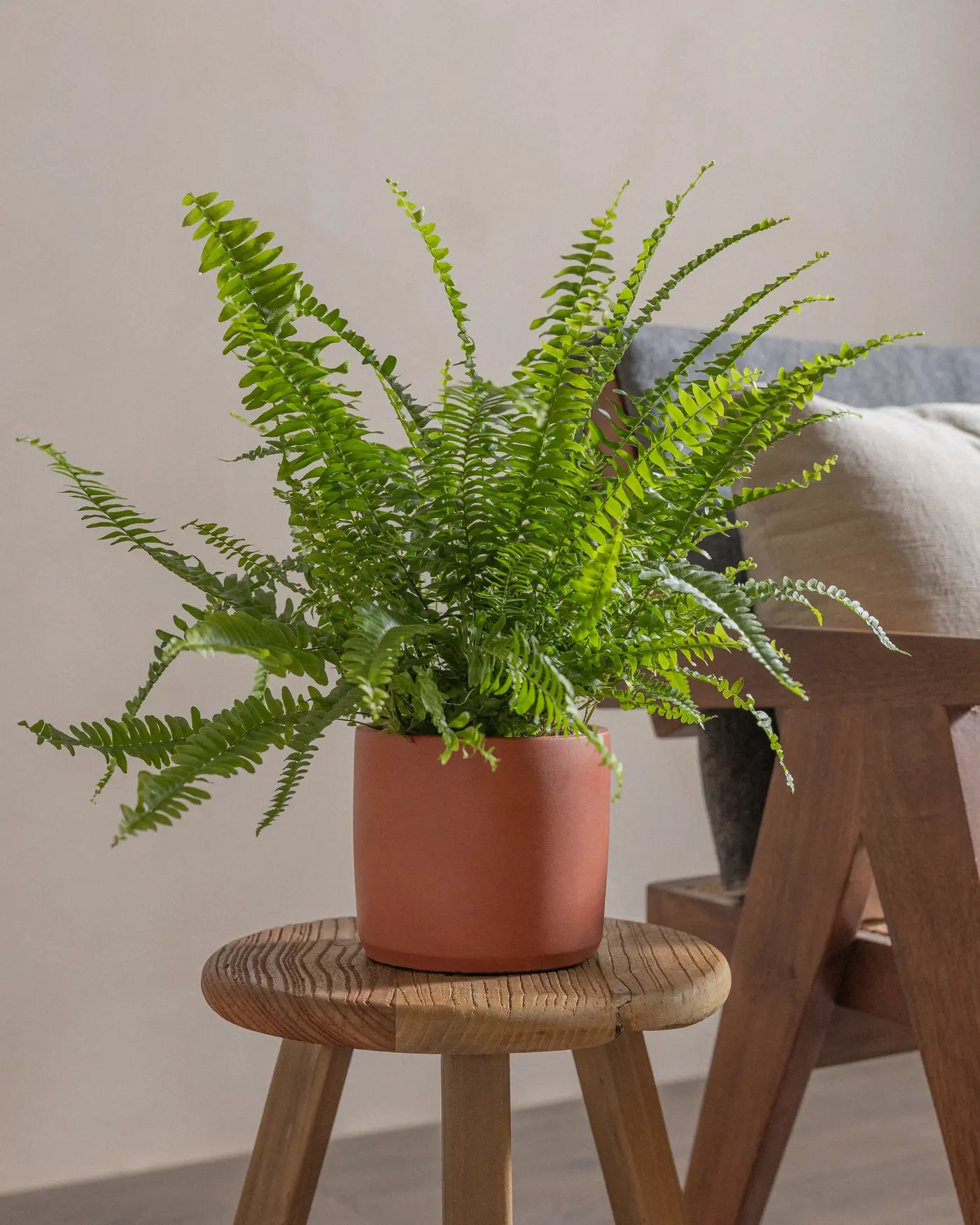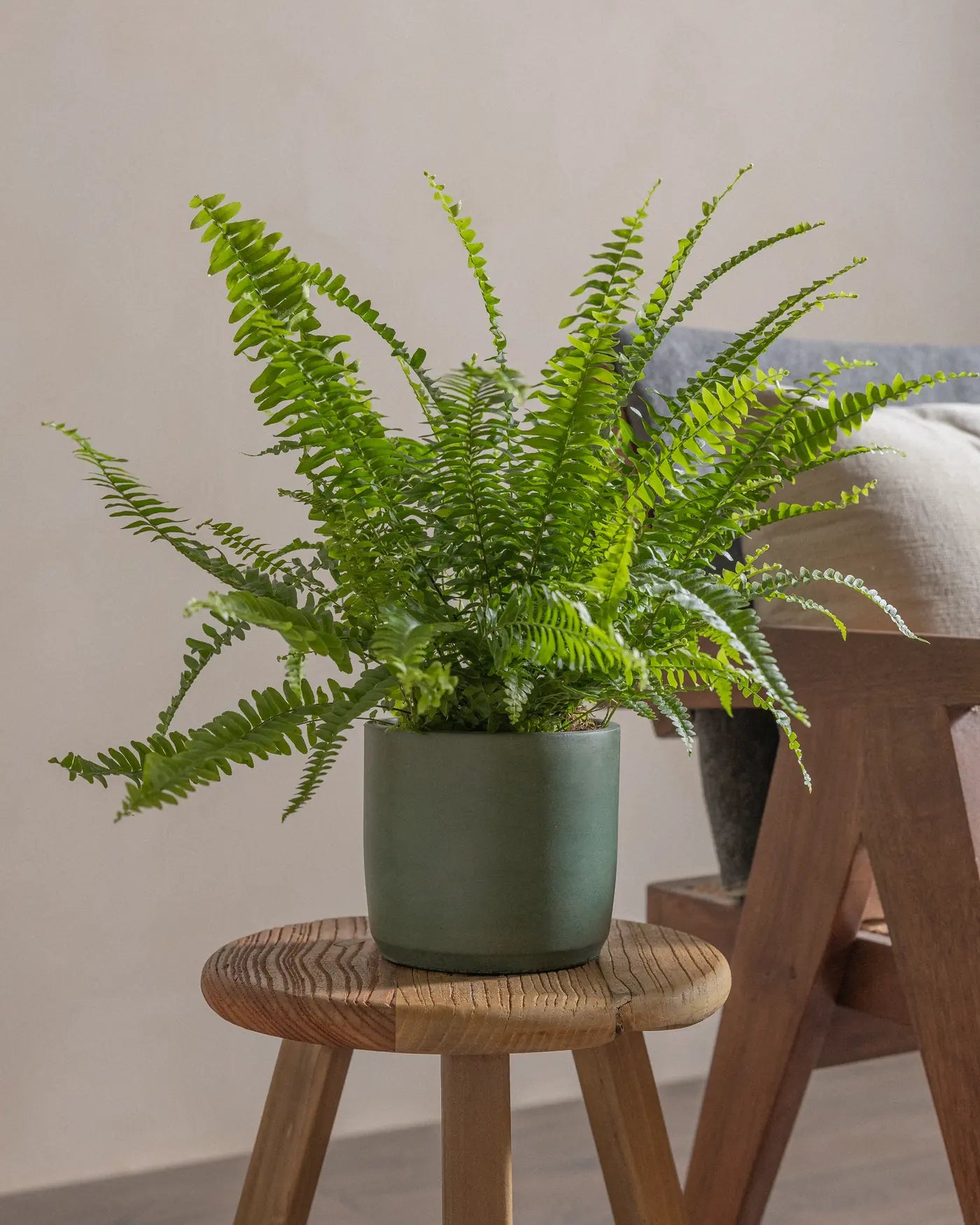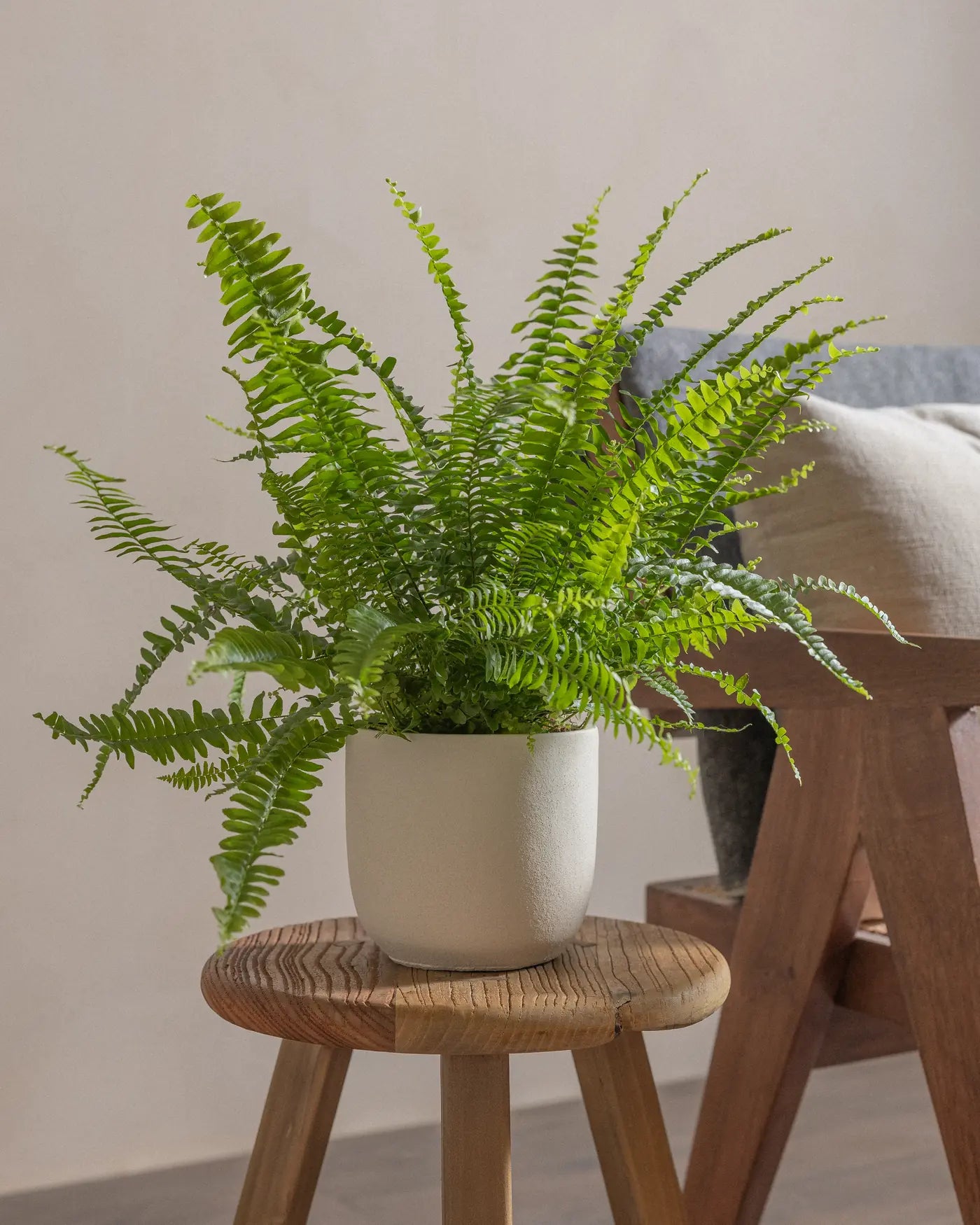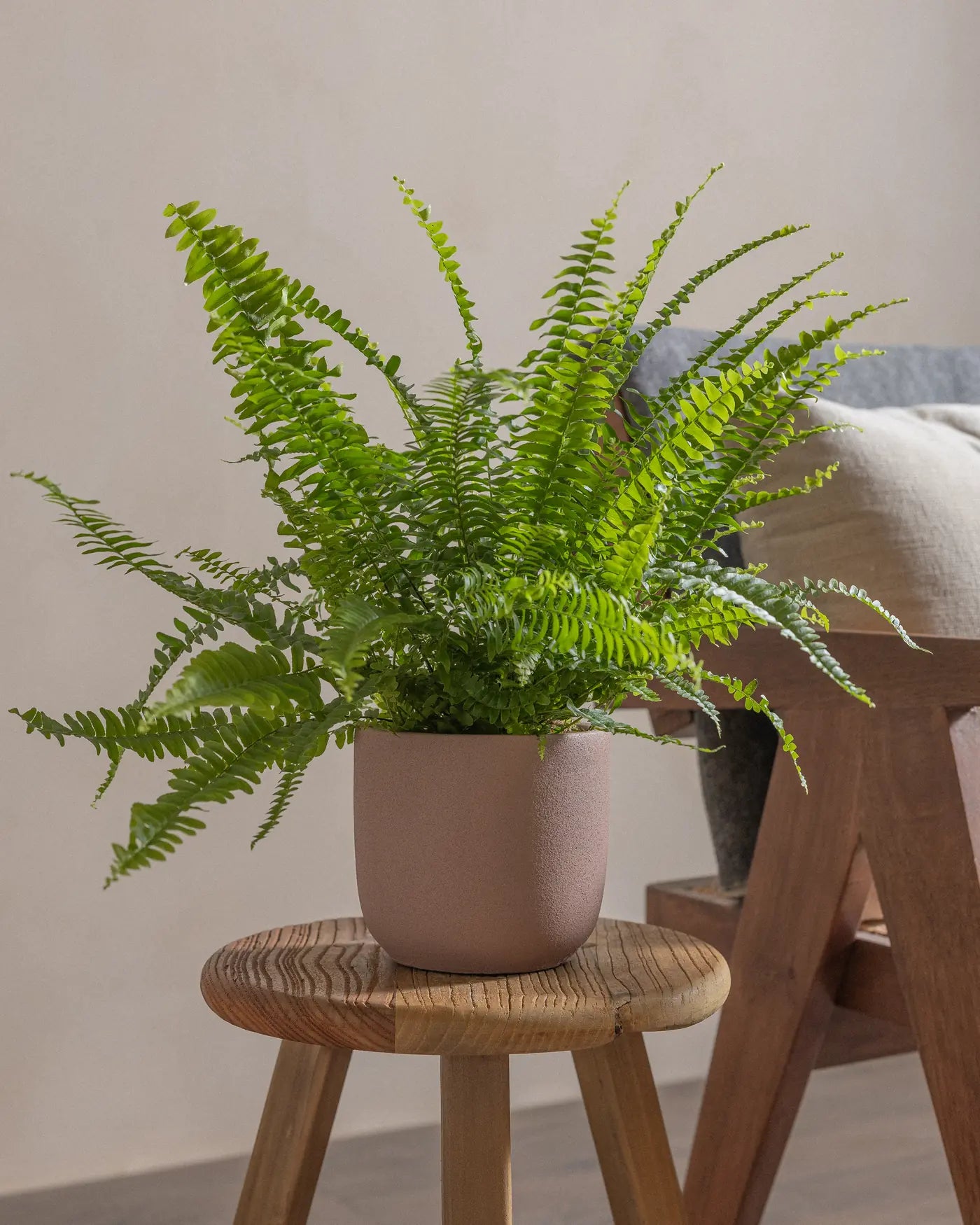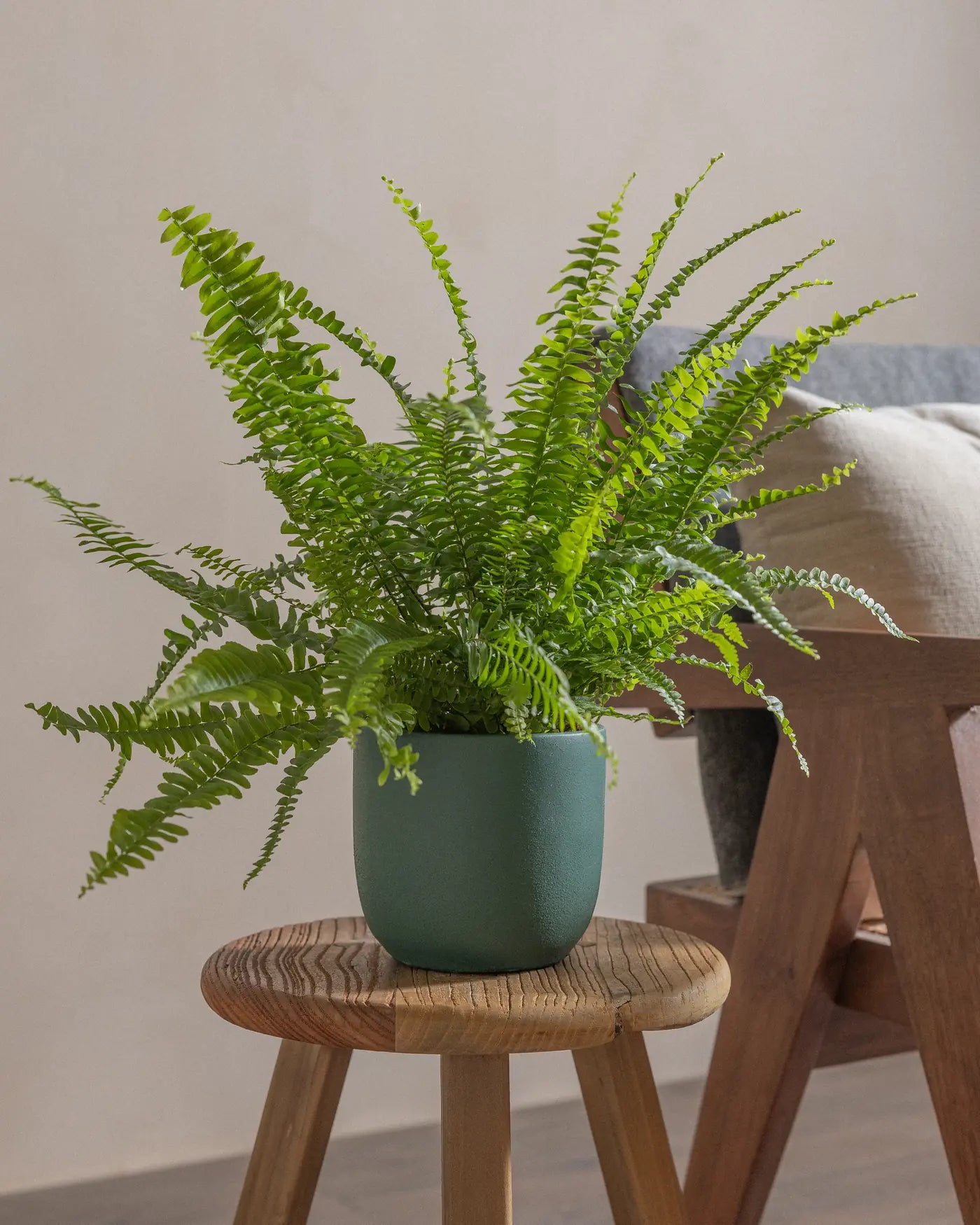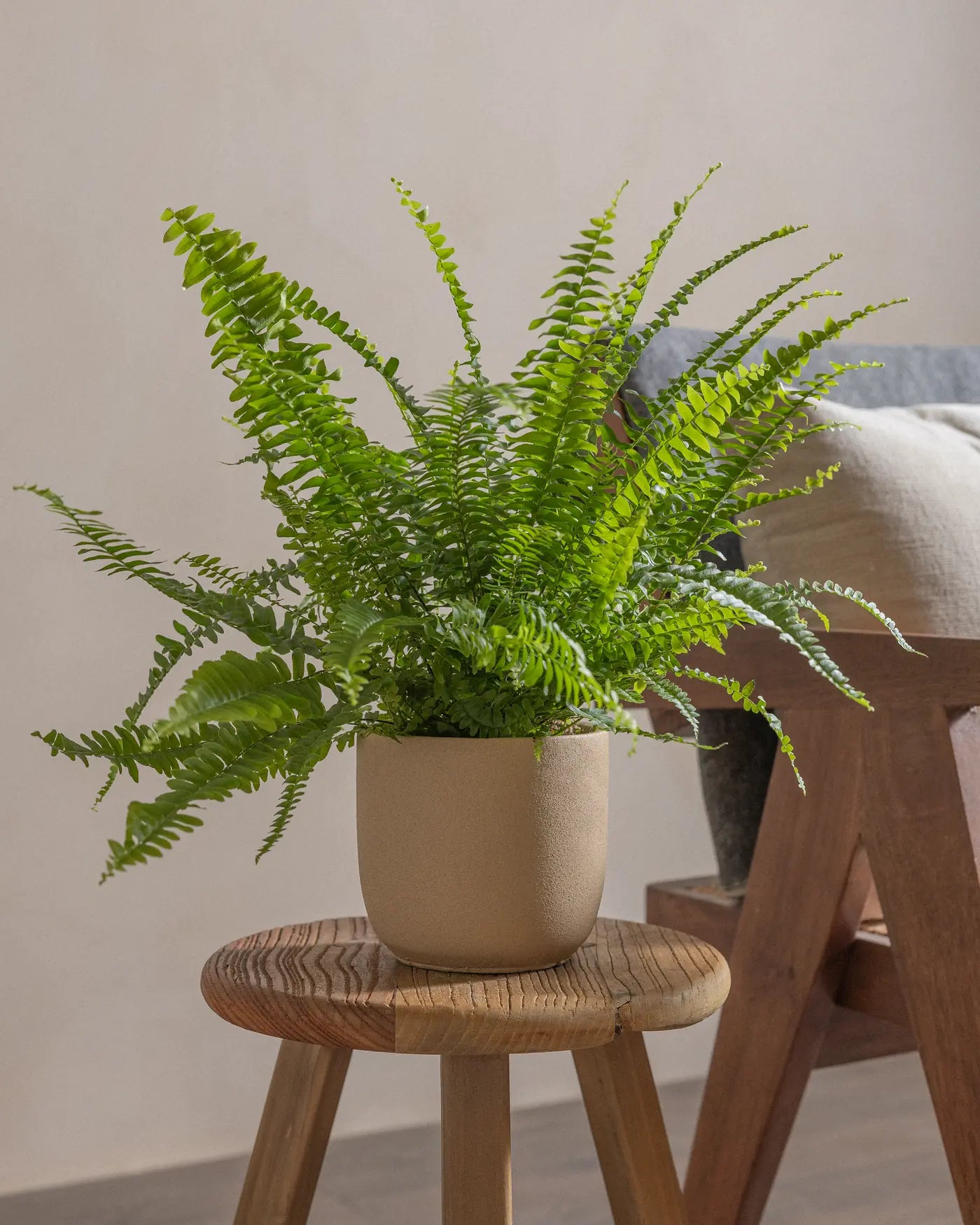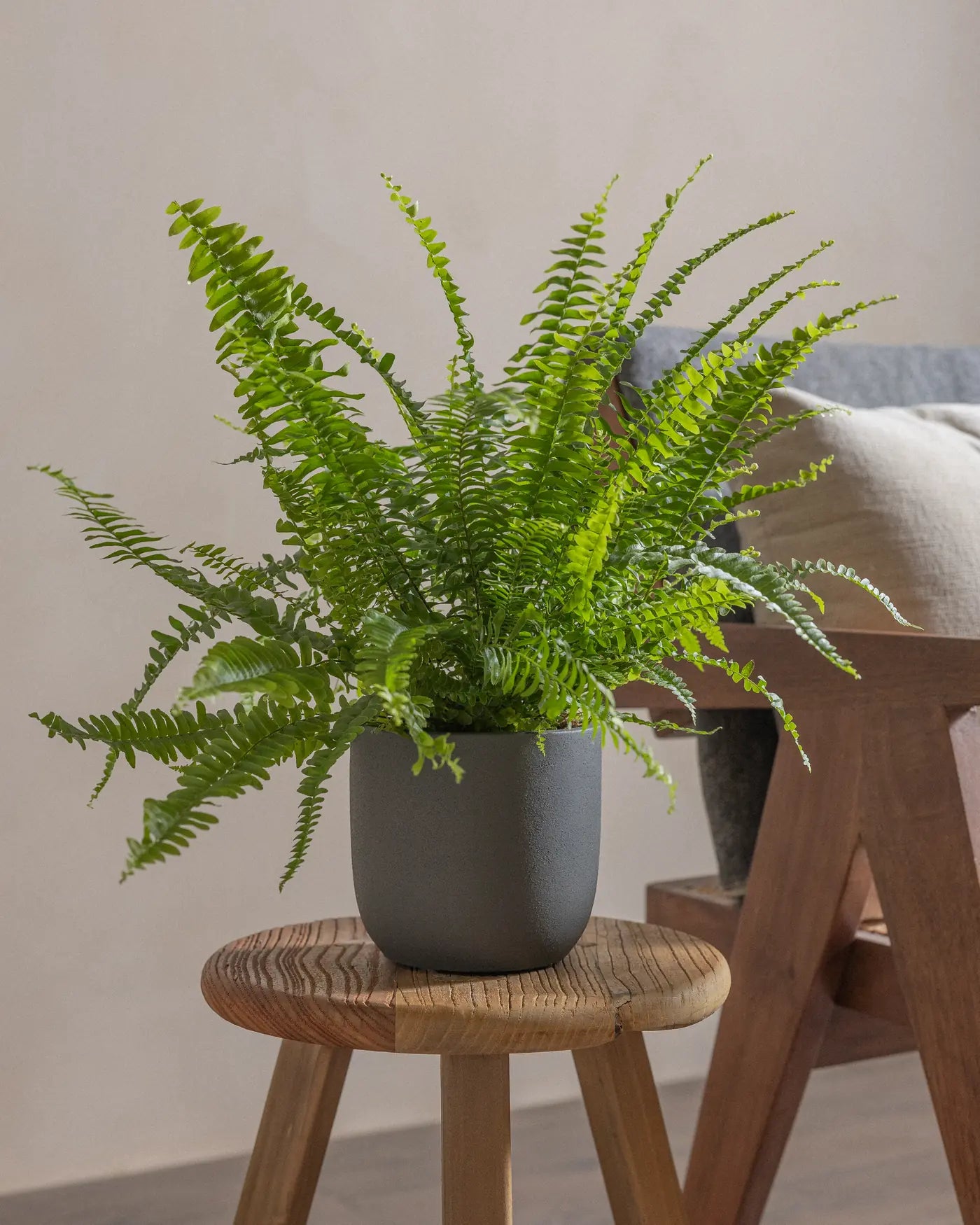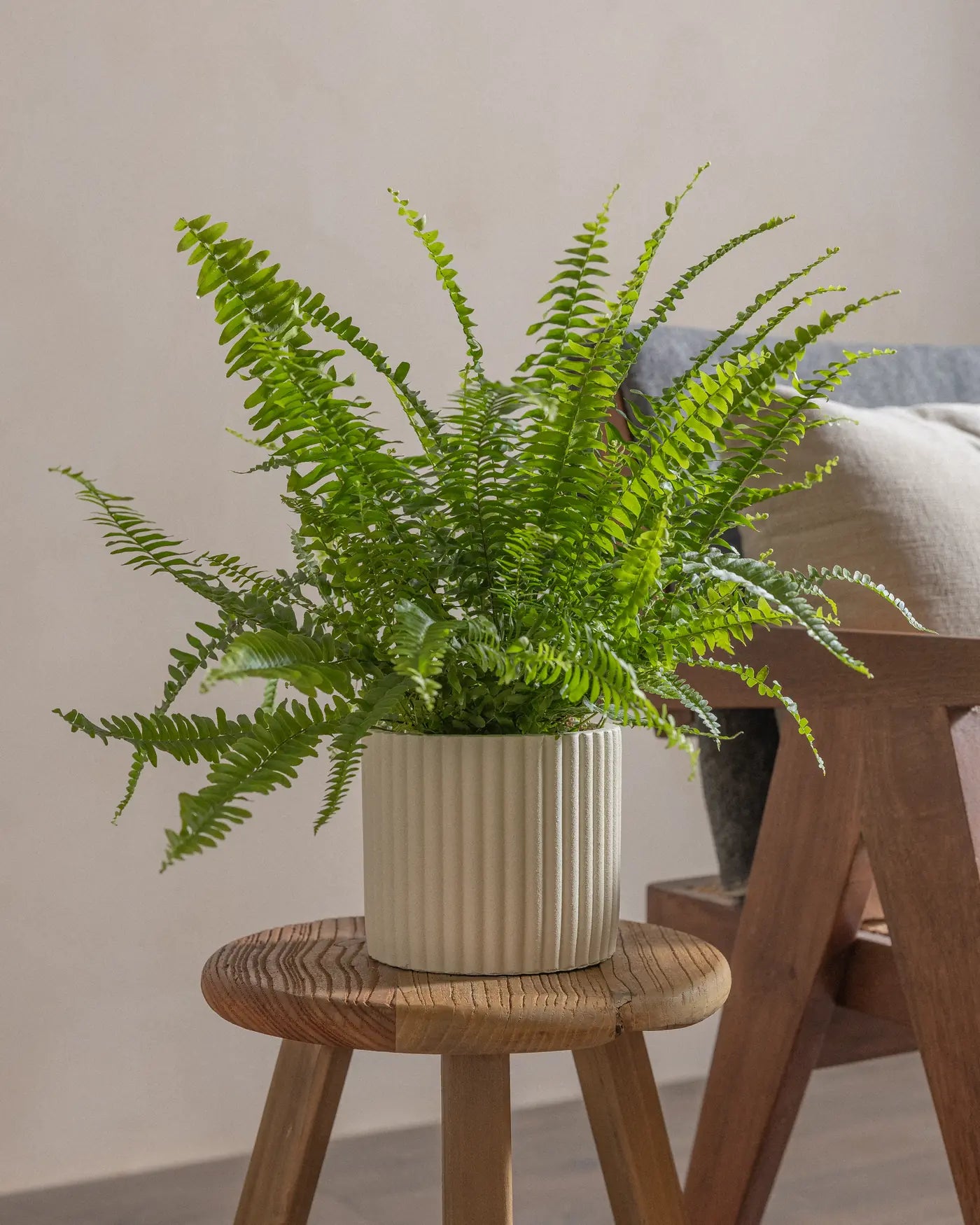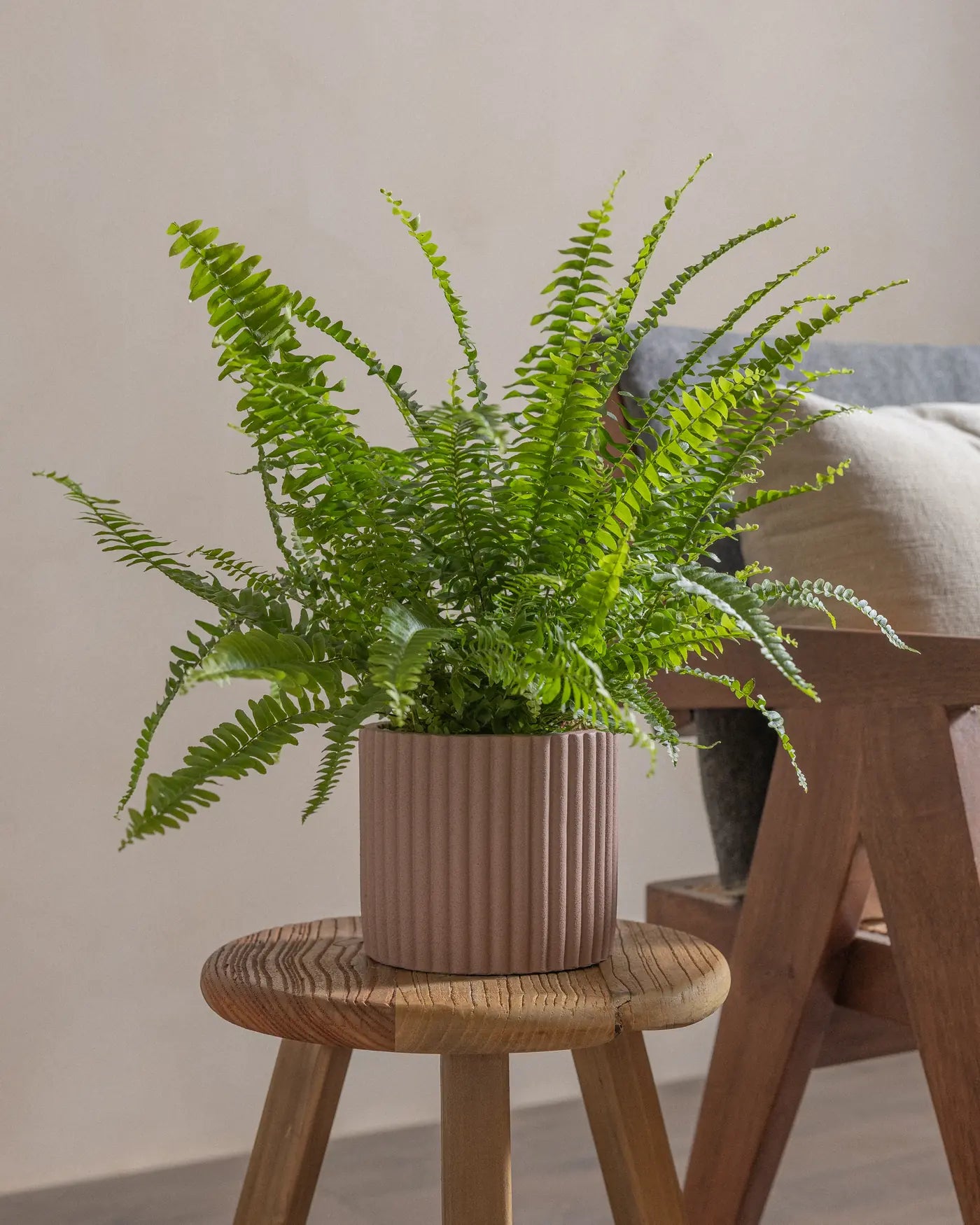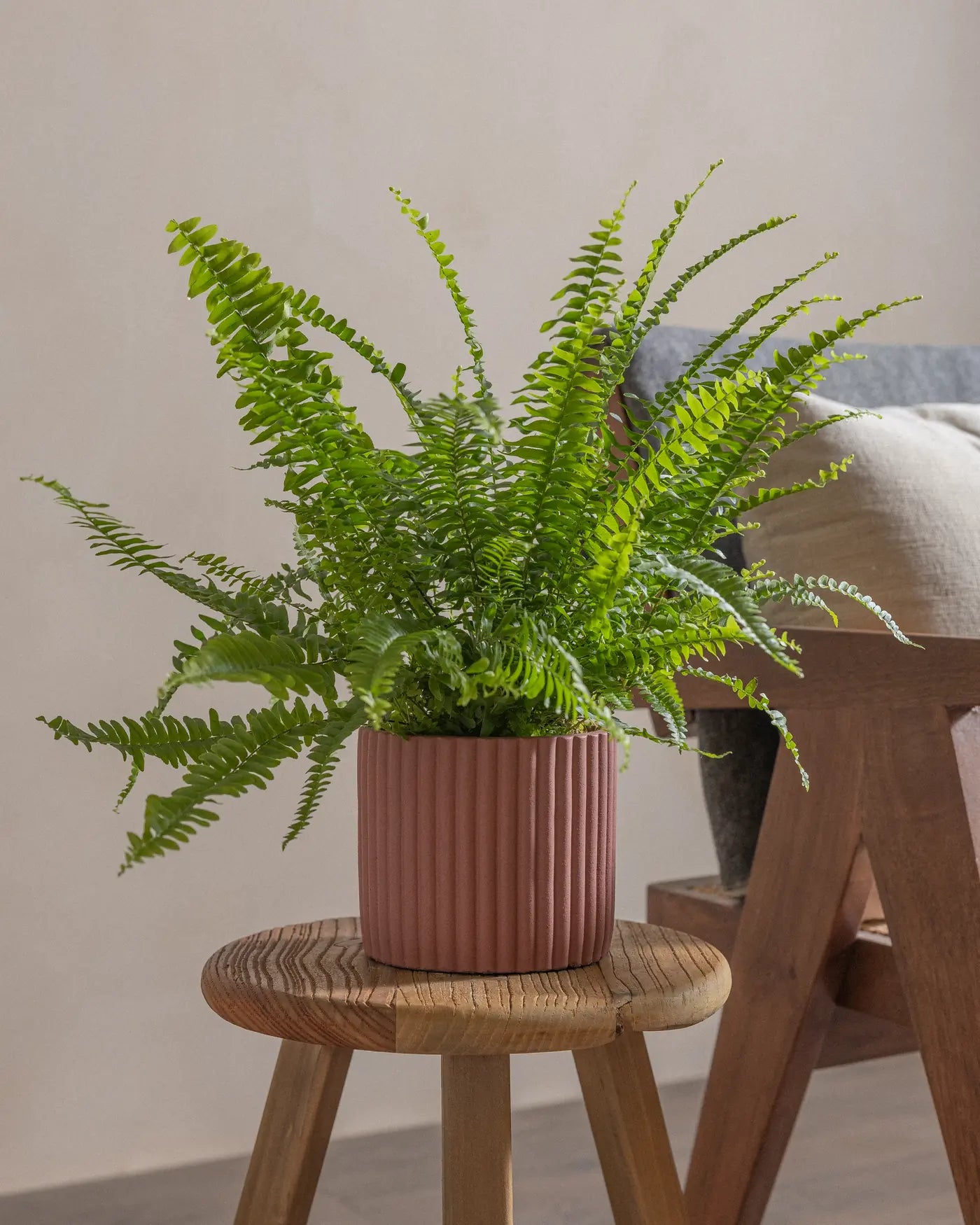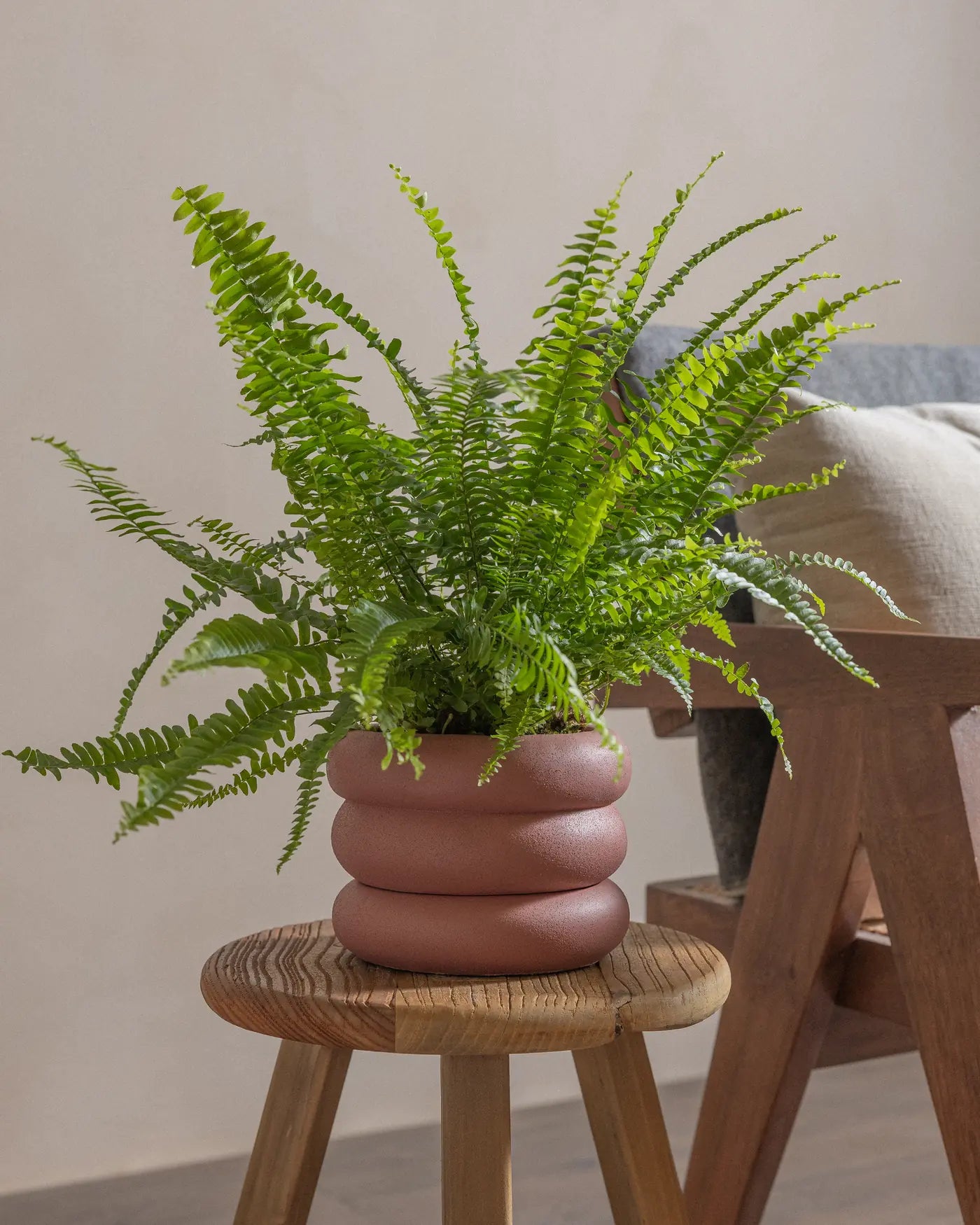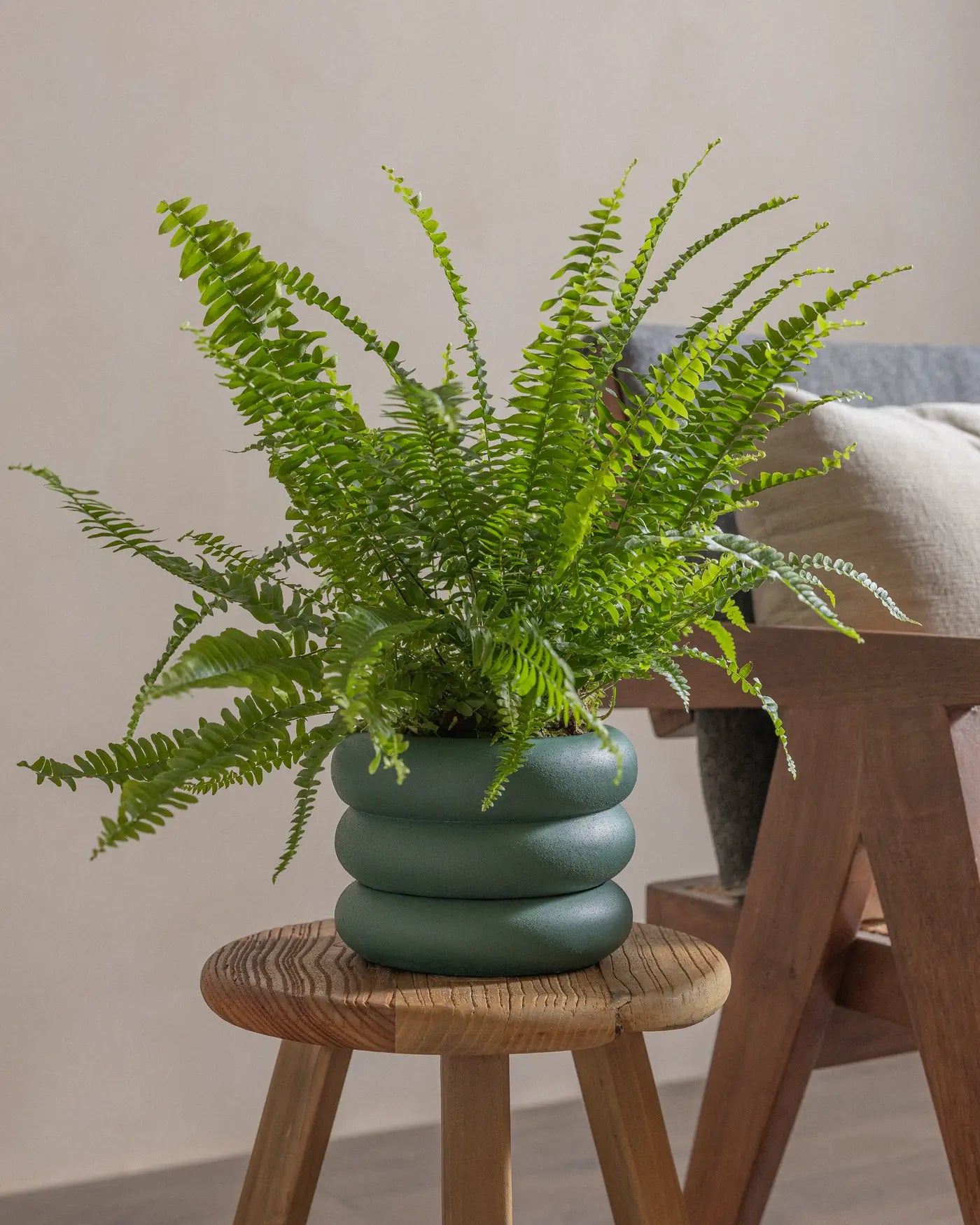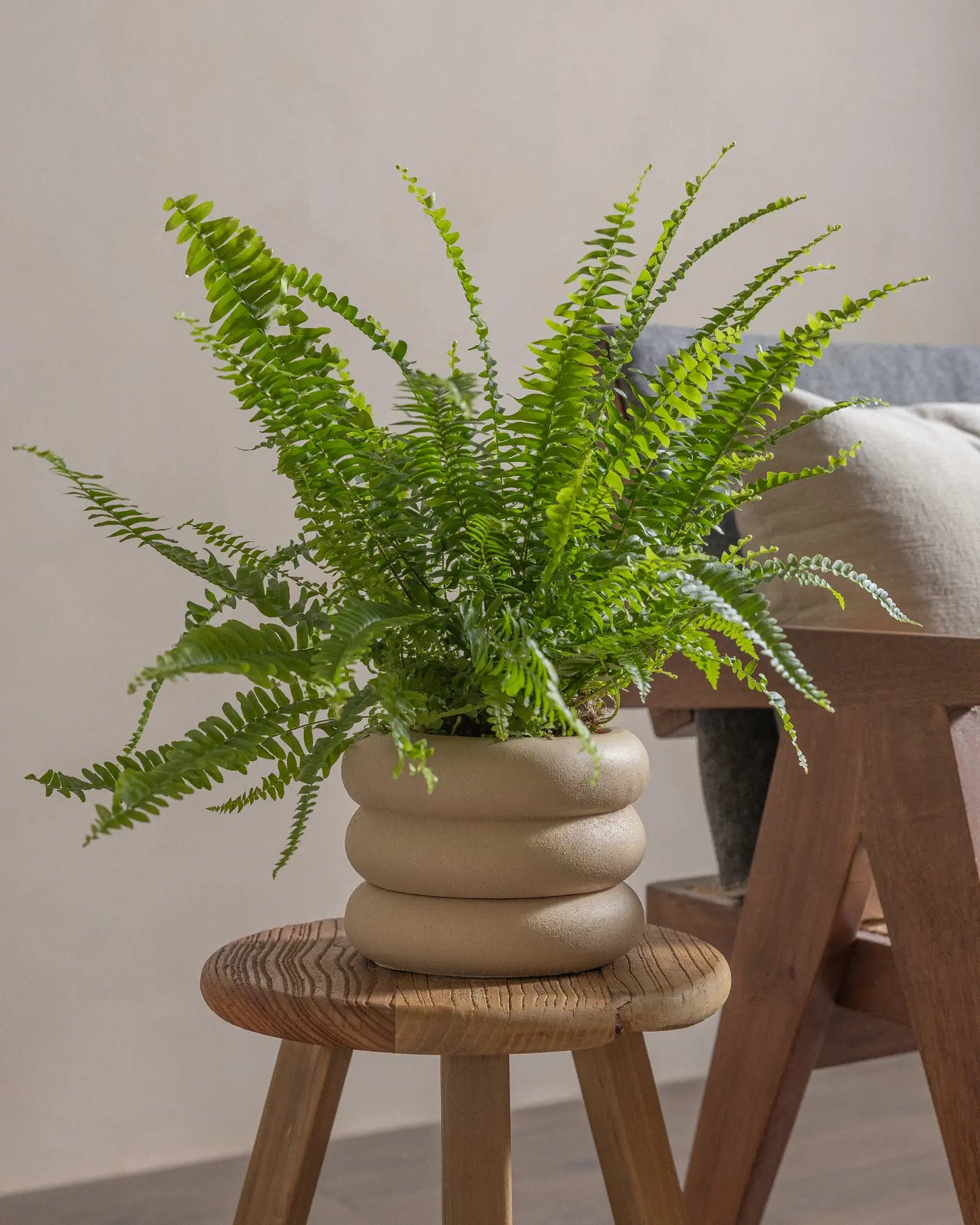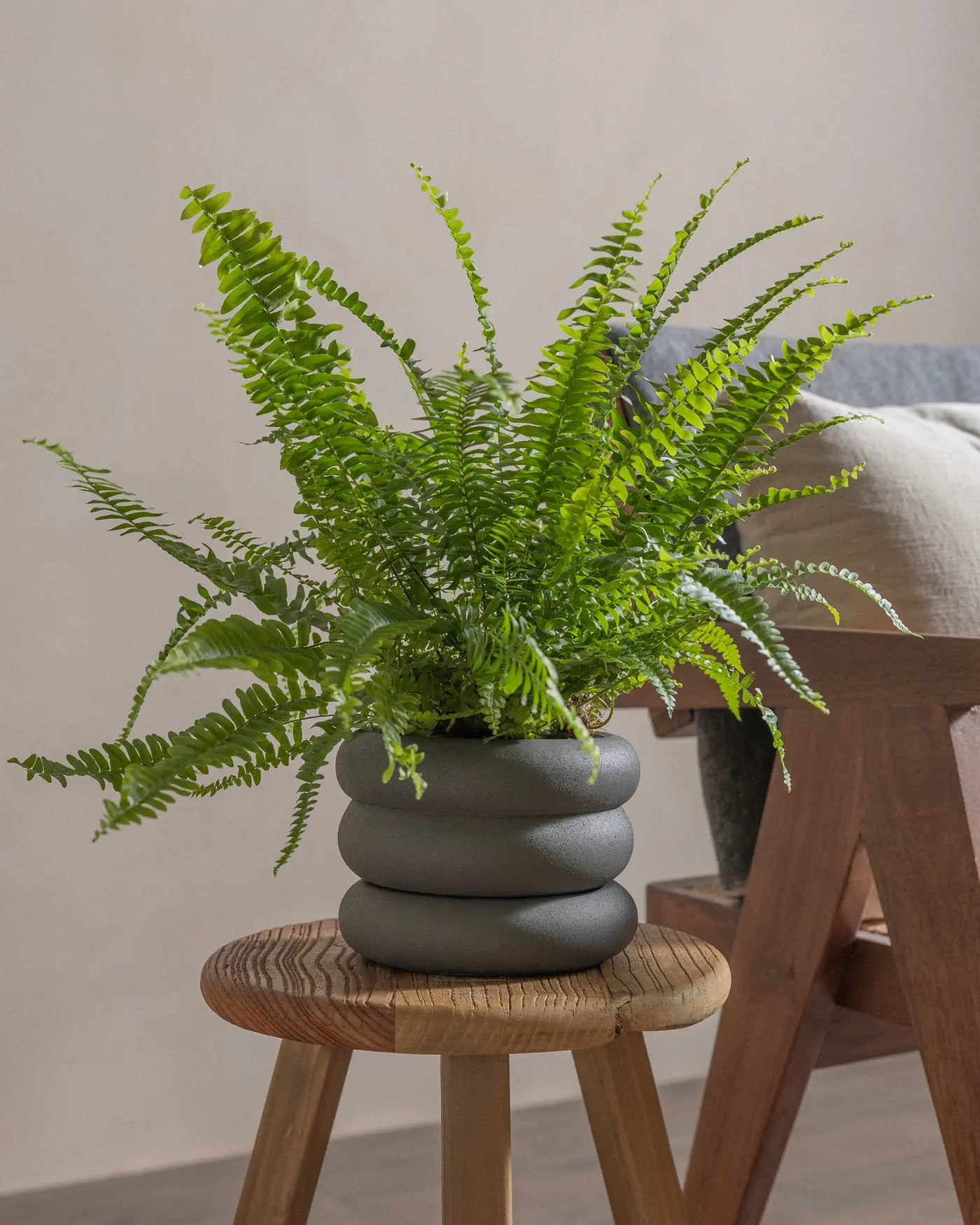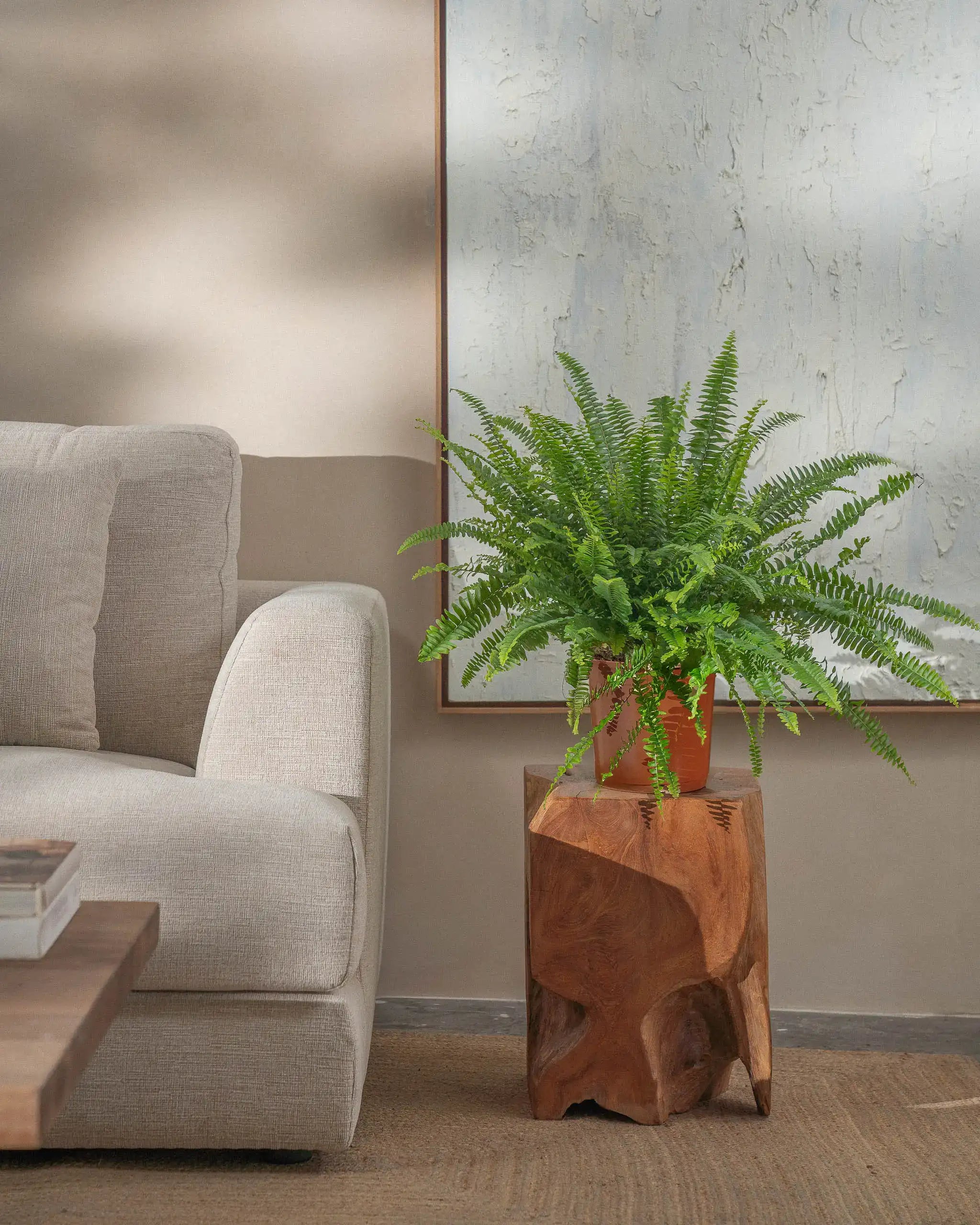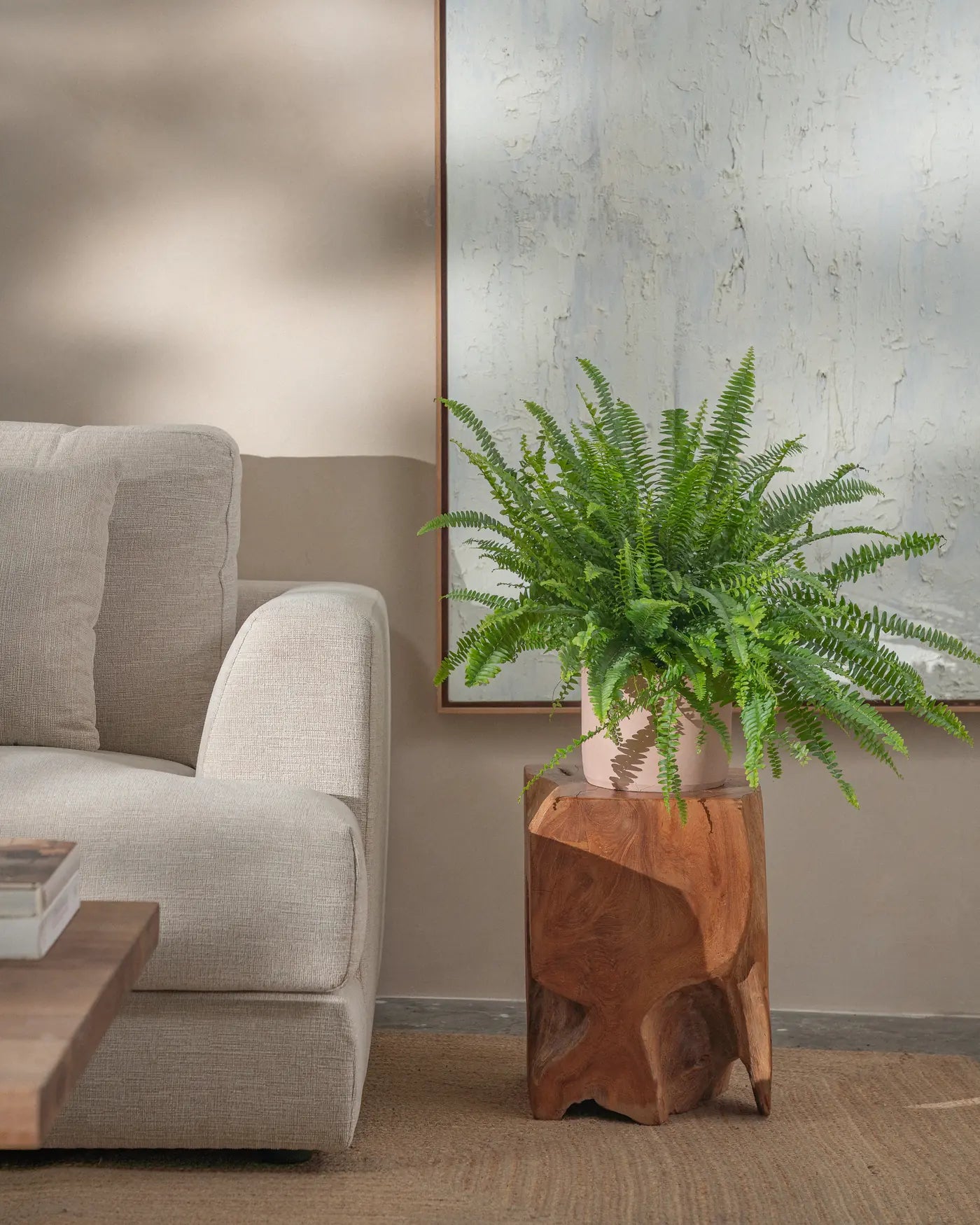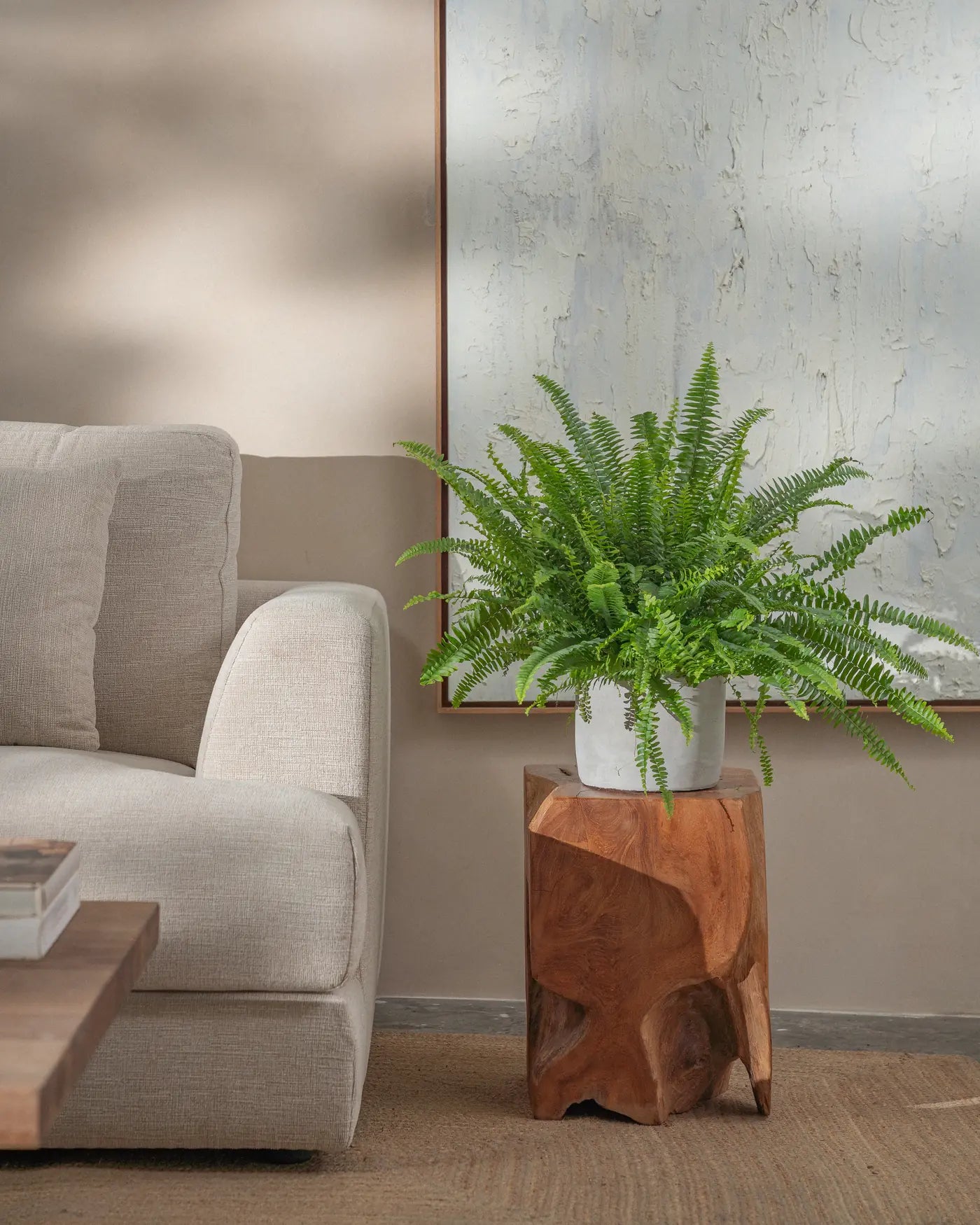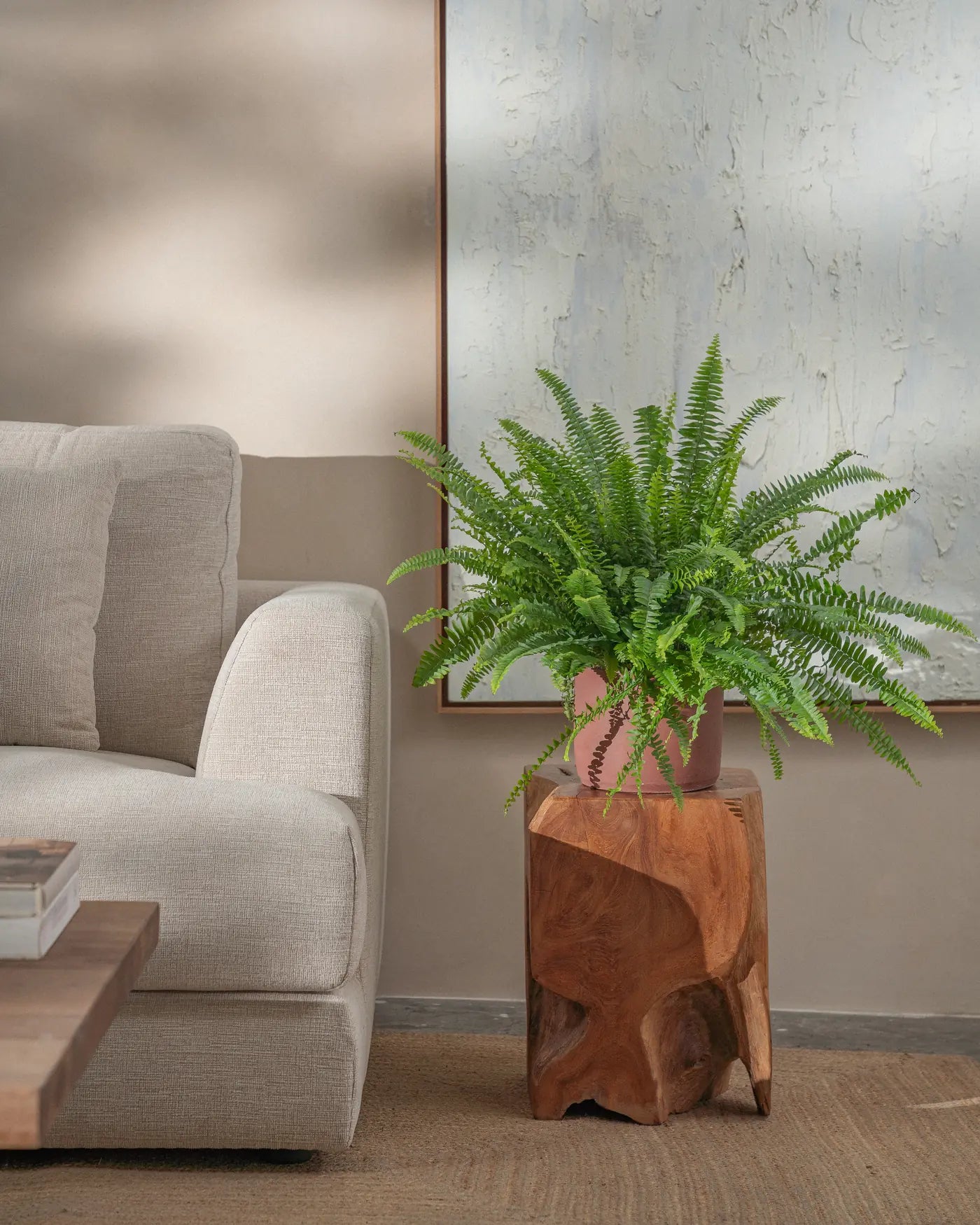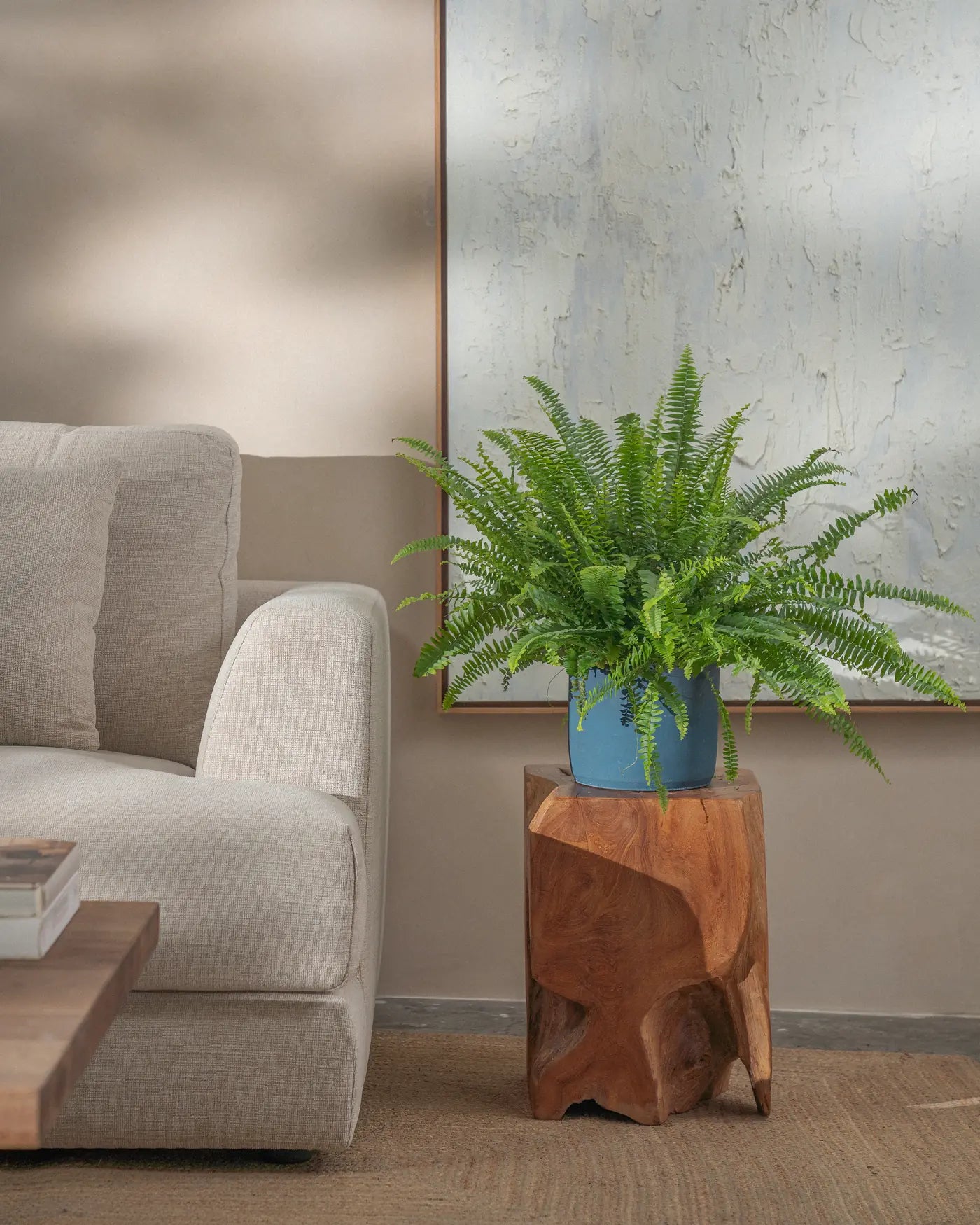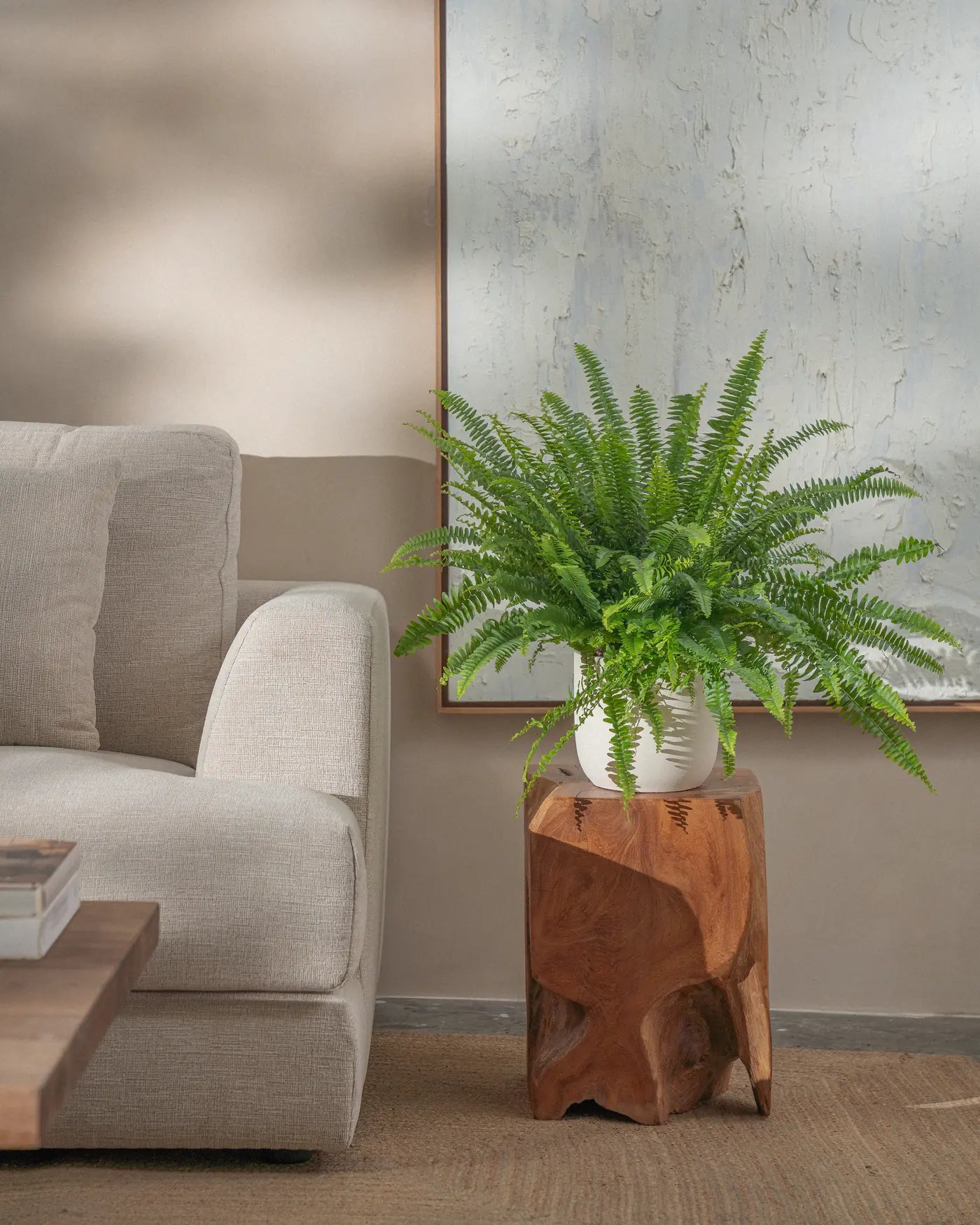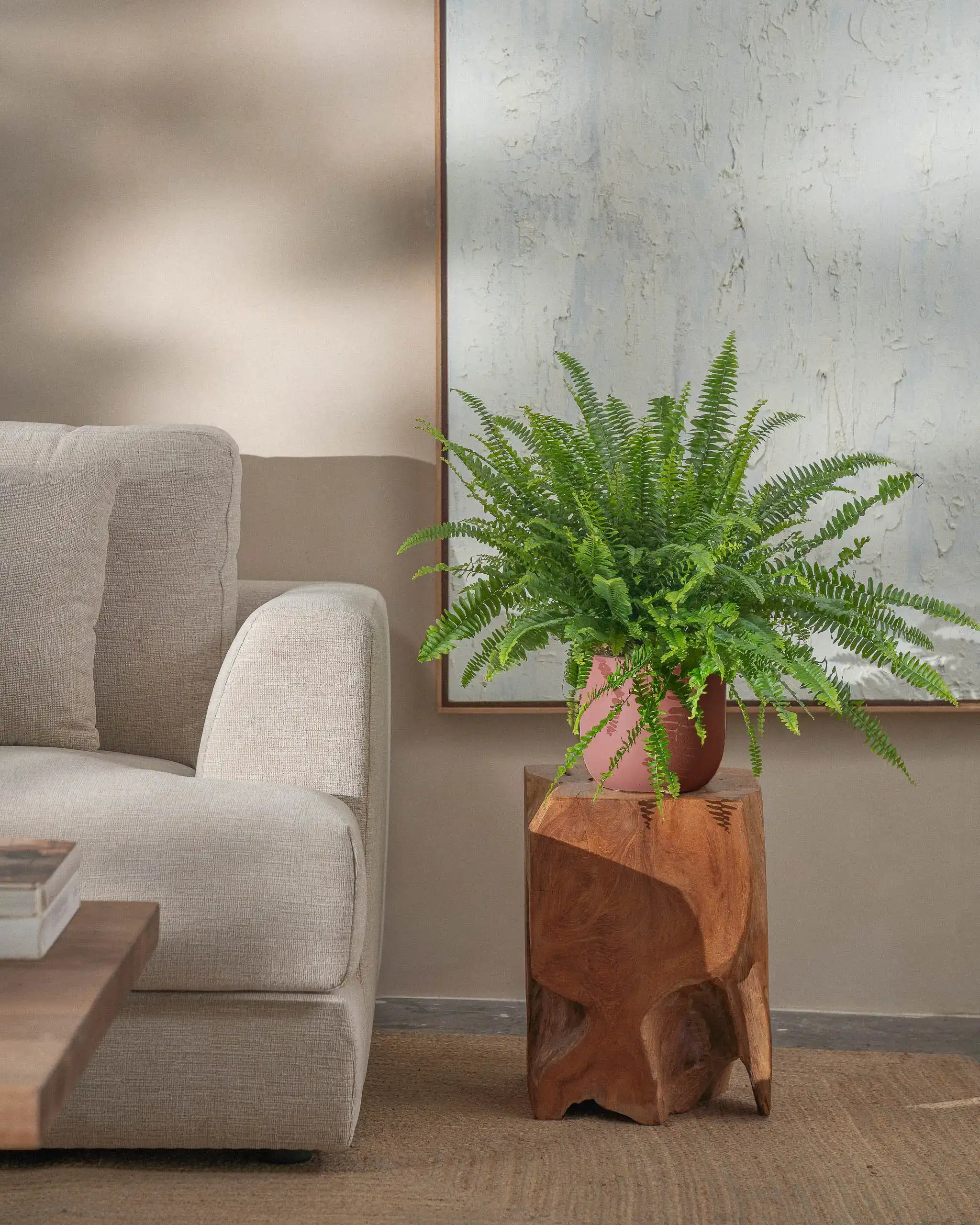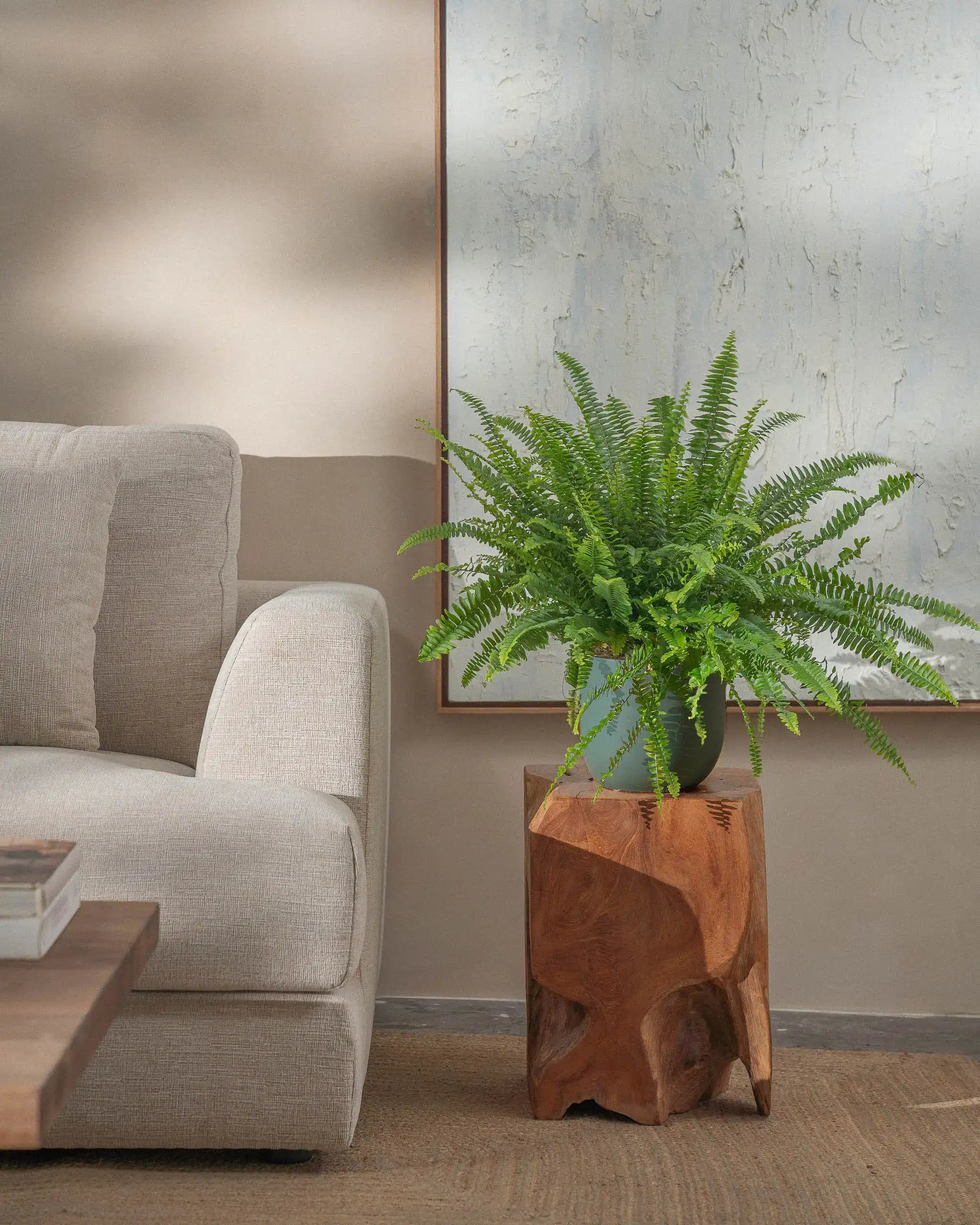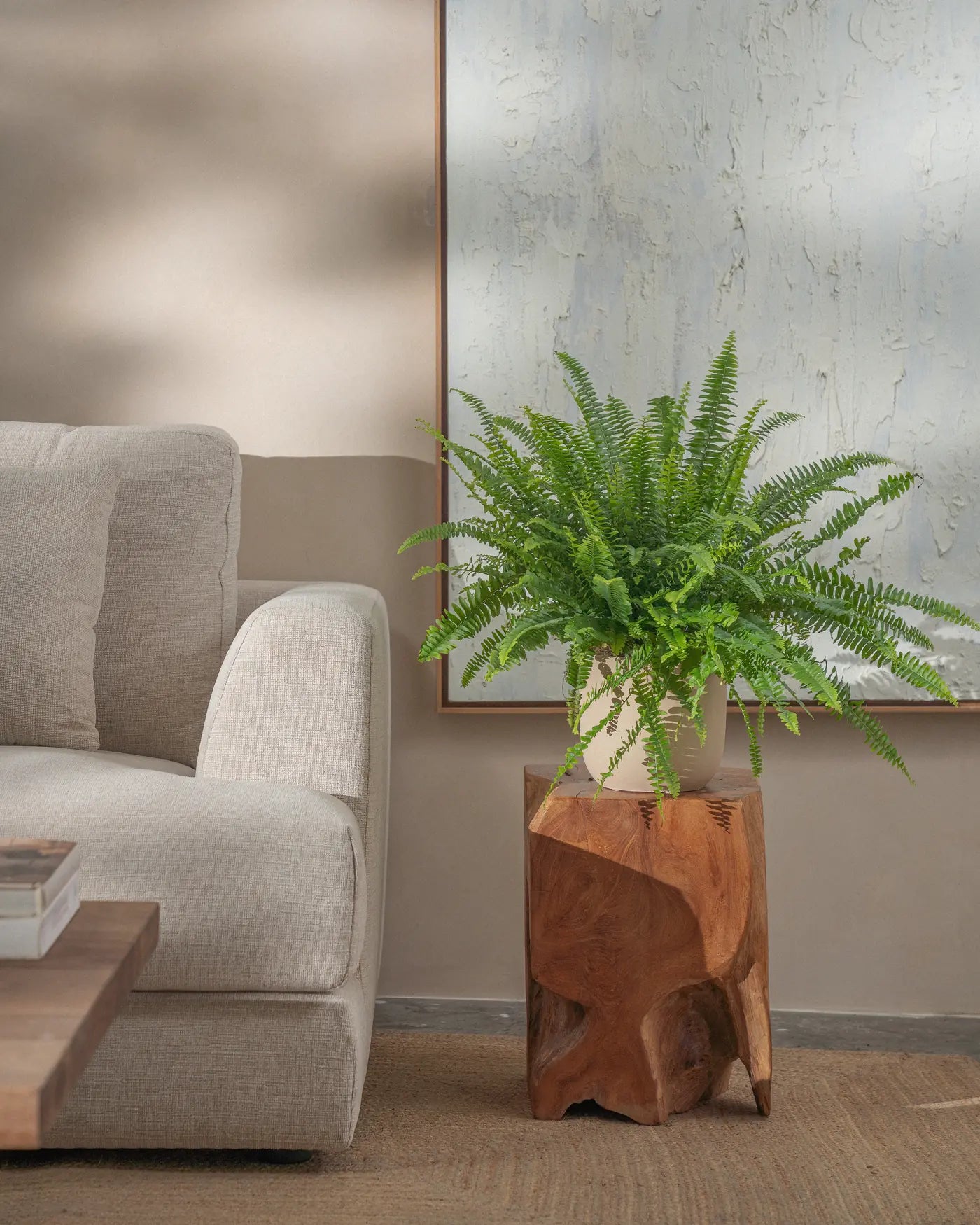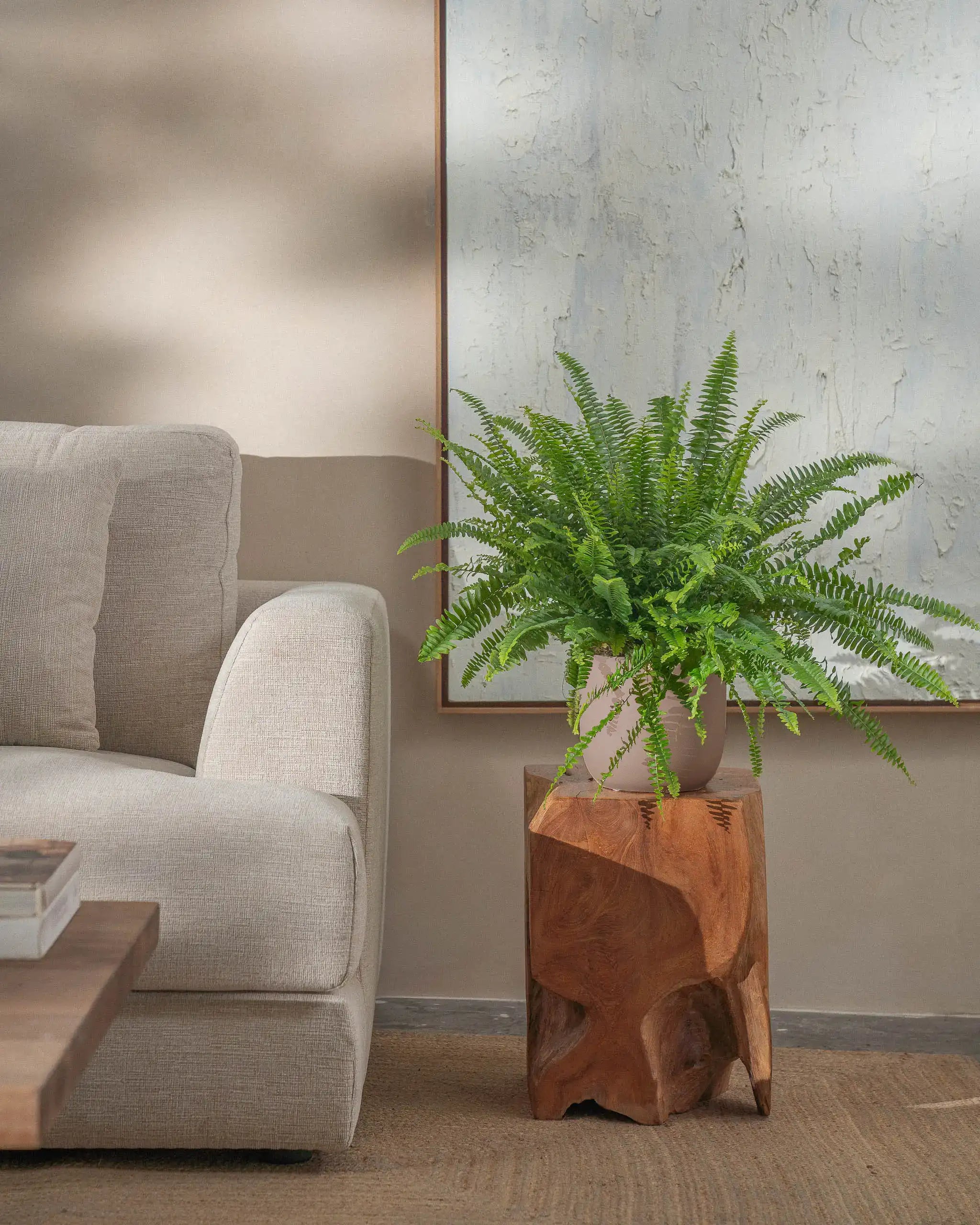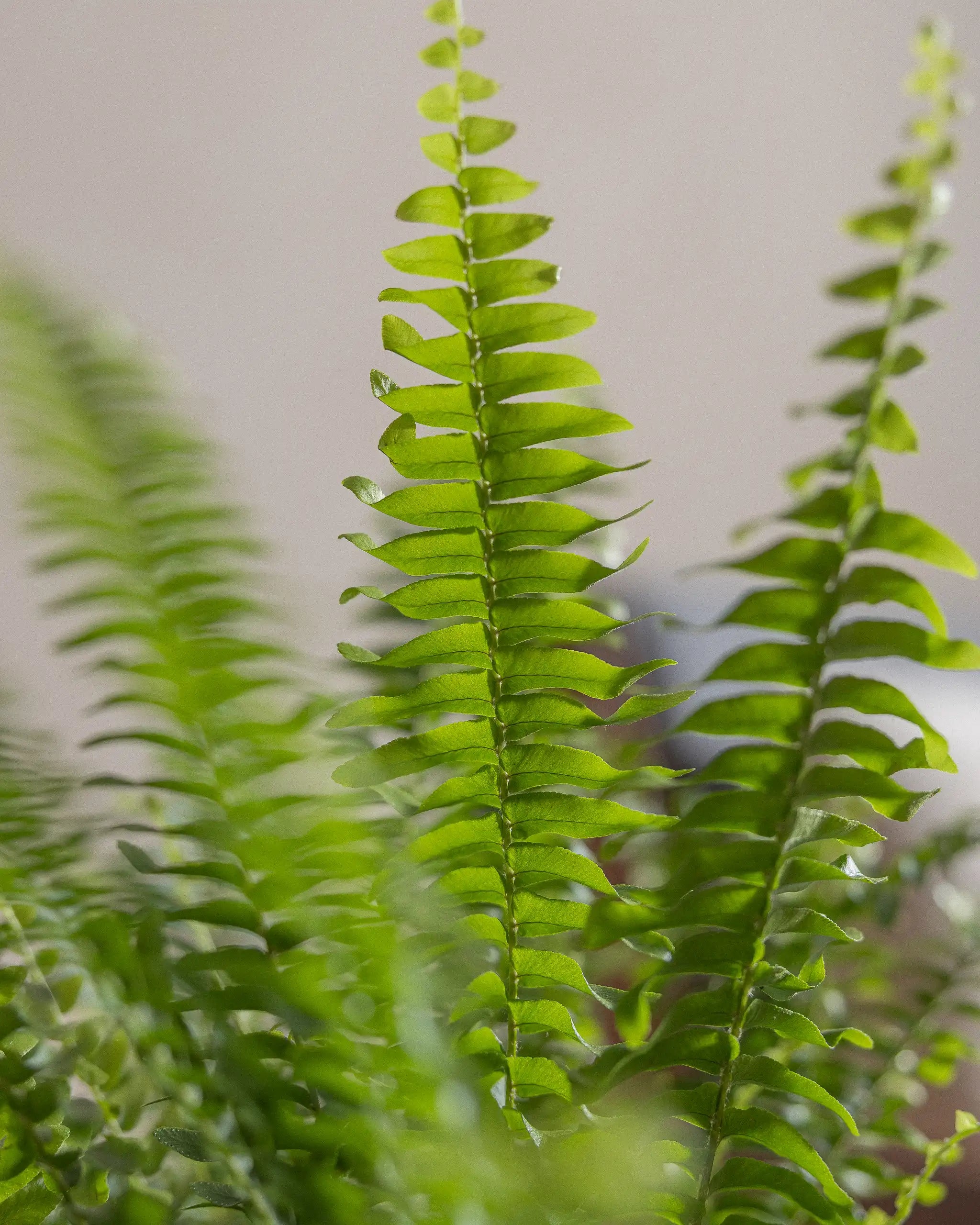How to care for and grow your Boston Fern Plant
(Nephrolepis)
Native to: Central America
Watering needs: Frequent – keep soil moist
Lighting needs: Can survive in low light but will shed leaves
Difficulty: Some care required
Great for: Adding personality to a room
Pet-Safe: Yes
Picking The Right Spot
(Lighting, Air Conditioning, Temperature)
Caring For Your Boston Fern
(Watering, Dusting, Re-potting)
How do I choose a healthy Boston Fern?
Boston Ferns are nothing but leaves.
It’s Alright If You See:
1. Dark Green Leaves: Green means healthy, and dark green means healthier.
2. Falling Leaves: Older leaves will dry and wilt and this isn’t an issue.
But, Watch Out For:
1. Excessive Falling Leaves: Usually a sign of underwatering.
2. Gray Leaves & Dark Roots: Indicate root-rot.
Where do I place my Boston Fern Plant?
(Lighting, Air Conditioning, Temperature)
Half of plant parenthood is choosing the perfect spot.
Lighting
The more indirect light your Boston Fern gets, the happier it will be.
Avoid direct sunlight (max: 2 hours) as that may burn its leaves.
When you bring your Boston Fern home, place it as close to a window as you can, making sure it has the largest possible view of the sky. Then, keep an eye on it for a few days. We highly recommend placing it near a window for the first month, so it gets acclimated to its new home.
If you see scorch marks on your Boston Fern, then that means it’s getting too much sunlight.
Pro-tip: You don’t need to worry about UAE windows, most of them are tinted, so the sunlight coming through is already filtered indirect light, not direct. If you were to keep your Boston Fern near a non-tinted window, you would see scorch marks on its leaves within the hour.
Air Conditioning
Place it away from AC vents
Like with most houseplants, place your Boston Fern as far away from the dry air escaping from your AC vent.
Temperature
Boston Ferns are happiest between 18 °C – 35 °C.
How do I care for my Boston Fern Plant
(Watering, Dusting, Re-potting)
How to keep your plant alive (and also show your love).
Watering
Maintain moist soil
As with most ferns, Boston Ferns like their soil kept mildly moist (but NOT soggy!). Wait until the top 2 inches of the soil is dry, then slowly water until water drips out the bottom of the drainage hole
Note: The more light it gets, the more often it’ll need to be checked and watered.
Leave water to aerate for 24–48 hours
Boston Ferns require a little more work as they’re more sensitive than other plants when it comes to chlorine and calcium found in tap water. To combat this, we recommend leaving your tap water out for 24–48 hours before watering to give the minerals time to evaporate.
Dusting
Once a month, gently wipe away any dust on your plant
Wiping your Boston Fern free of dust with a damp rag once a month will help it soak in light and breathe through the little pores on its leaves (stomata).
Re-potting
Leave it in its nursery pot
Once you receive your plant, place it in the spot you plan to keep it in (whilst still in its nursery pot) and allow it at least 6 months (ideally 12) to acclimate to your home's temperature and light levels.
Time to re-pot
Boston Ferns won't need to be re-potted more than once every 2-3 years.
When it's time, use a high-quality potting mix and transfer your Boston Fern into a pot that's about 1–2 inches in diameter larger (or one or two sizes up) than its current one.
When in doubt, reach out to our team at hello@plntd.ae, and we’ll help you identify whether the soil bag you’re considering will work for your Boston Fern.
Remember, always go for a pot with drainage holes.
Pro-tip: To keep watering simple and easy, you can simply re-pot your Boston Fern into a larger nursery pot and place that nursery pot in a larger planter.
Frequently asked questions about Boston Fern Plant
Ask away, grasshopper.
How easy is a Boston Fern to care for?
Boston Ferns plants require a little more care than the average indoor plant:
- They like their soil to remain moist (though never soggy) and so need to be watered every 1-2 weeks. The more light they get, the more you can expect to water them.
- These plants are native to the humid tropical forests of northern South America and love high humidity; something to combat with the dry AC air that is so common in the UAE. As a result, you may need to increase humidity around your plant, we suggest using the pebble-tray method, or getting a humidifier.
Like most indoor plants, Boston Ferns are a little sensitive when it comes to the chlorine and calcium found in UAE tap water, however. To combat this, make sure to:
- Leave tap water out for 24-48 hrs before using it. This will allow the chlorine time to evaporate.
- Water all the way through the soil until water is dripping out the bottom of the nursery pot. This will ensure any excess build of calcium (and other minerals) is flushed out from the soil.
How much light does my Boston Fern need?
In their natural habitat, Boston Ferns grow on forest floors and have, therefore, evolved to grow in the shade, under the canopies of tall trees.
Your Boston Fern will thrive in similar medium-light conditions. As long as there is a window in the room it's placed in; it will be happy.
Can I use UAE tap water to water my Boston Fern?
Yes. Boston Ferns can be fed using UAE tap water.
However, like most indoor plants, they are sensitive to the chlorine and calcium found in the water.
To combat this, make sure to:
- Leave tap water out for 24-48 hrs before using it. This will allow the chlorine time to evaporate.
- When watering your Boston Fern, make sure to water through the soil until it is dripping out the bottom of the nursery pot. This flushes out any excess build-up of calcium (and other minerals) from the soil.
Finally, look out for tell-tale signs of too much chlorine or calcium:
- Scorched brown tips at the leaves = too much chlorine.
- White crystals on the soil = too much calcium.
Will AC harm my Boston Fern? What temperature should I set it to?
Boston Ferns are tropical plants native to the warm, humid, climates.
ACs achieve the opposite results: they make the temperature colder, and the air dryer.
Here are some tips to keep in mind when setting your AC temperature and deciding where to place your Boston Fern in a room:
- The ideal temperature for Boston Ferns is between 18 °C – 35 °C. Though they CAN tolerate lower temperatures, you'll need to REDUCE your watering drastically, as the risk of overwatering increases the lower the temperature is.
- Whenever possible, place your Boston Fern (this applies to all plants) as far away from the AC vent as possible.
- To combat the drying effect of the AC, increase humidity around your plant using the pebble-tray method, or by getting a humidifier.
Do I have to re-pot my Boston Fern as soon as I receive it?
In short, no.
Once you receive your plant, place it in the spot you plan to keep it in (whilst still in its nursing pot) and allow it at least 6 months (ideally 12) to acclimate to your home's temperature and light levels.
Once acclimated, you can choose to either re-pot your plant or leave it in its nursing pot.
Boston Ferns won't need to be re-potted more than once every 2-3 years, but you can choose to re-pot sooner if it has acclimated to its current environment.
Some Common Problems
Don't let this list scare you — trust us, Boston Ferns are easy to care for.
Brown Leaf Tips
Cause 1: Dry climate
Suggestion: If your plant is placed next to an AC vent, try moving it to an area with less dry air flow. You can also Increase humidity around your plant using the pebble-tray method.
Cause 2: Minerals in water
Suggestion: Leave water to aerate for 24–48 hours, allowing minerals to evaporate.
Cause 3: Too much fertilizer
Suggestion: Give your Boston Fern a good shower to rinse out as much fertilizer as possible, or, better yet, re-pot it using fresh high-quality potting soil.
Drooping Leaves
Cause: Not enough light
Suggestion:Try to move it to a spot that receives more sunlight.
Dry or Curling Leaves
Cause: Underwatering
Suggestion: Time for a drink!
Falling Leaves
Older leaves will always dry and wilt; this shouldn't be alarming. However, if your fern is losing leaves excessively, then this is usually due to underwatering.
Gray Leaves
Cause: Root rot
Suggestion: Overwatering and inadequate drainage can cause root rot. You can salvage your fern by discarding old stems, roots and soil and re-potting your plant into a new pot.
Leaves Curling or Falling over
Cause: Overwatering
Suggestion: Allow soil time to dry out completely (sometimes this can take 2-4 weeks), then slowly re-water.
Leaves Turning Lighter Green/Yellow
Cause: Too much sunlight
Suggestion: Move it farther away from the window.
Buying Boston Ferns Online
When shopping for a plant online, look out for the following:
Height
If you're looking for a table-top plant, then go for one that's 40cm tall. A 60cm tall plant would work well on a low side-table. Plants about 1 meter or taller would work well as statement floor plants.
Note: Stated heights will always include the height of the plant AND planter.
Pot style
This is all about the vibe you're looking for, and you'll typically have a choice amongst different colors and shapes.
If you're looking for subtlety, we suggest a circular pot in white. To make more of a statement, look for contrasting shapes and colors!
Delivery
It goes without saying that your plant supplier should meticulously package all plants.
When you personally buy a plant from a store, you're able to rush it home, ensuring it stays outside for as little time as possible. But when you order online, your plant will ride-share with a lot of other plants all on their way to their new homes.
Depending on where you live, weather can play a big part in your plant's health along the way.
If possible, ask your plant shop what precautions they take to ensure your plants stay as safe as possible en route to you.
Reviews
Reading customer reviews is a good way to get an idea of the customer experience provided by the seller (here's ours, by the way), but you need to practice caution there.
Don't expect to be able to tell a fake review right away, some reviewers can be great con artists, and some negative reviews can be fake to harm the seller.
Your best bet is to zoom out and look at multiple comments from multiple categories to get a good overview of whether you can trust this company and/or their review section.
For example, look at how recent the reviews are, and how spread apart. Was there a sudden spike of comments in a short amount of time? Do they sound like they're all written by someone rehashing the same template? Do they all sound too positive to be real?
Yes, going all detective on reviews can be a chore, but Future You will thank you for it.
Returns and refund policies
Things can go wrong.
Sometimes it's no one's fault, and sometimes there's nothing anyone can do.
So the best practice is to offer (and honor) a no-questions asked return/refund policy. Check out the seller's policy before you make a purchase, so you know you're insured in case things don't work out.
You can check out our return/refund policy here.
Ready to adopt a Boston Fern?
Your Boston Fern can't wait to meet you — just choose a height and pot and let's introduce you two!
Boston Fern Indoor Plant is one of the oldest plants in the world. This makes them perfectly suited for bathrooms and other hot and humid spaces.

